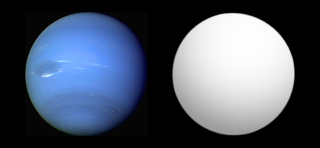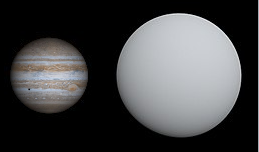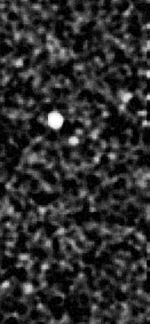
A Super-Earth is a type of exoplanet with a mass higher than Earth's, but substantially below those of the Solar System's ice giants, Uranus and Neptune, which are 14.5 and 17 times Earth's, respectively. The term "super-Earth" refers only to the mass of the planet, and so does not imply anything about the surface conditions or habitability. The alternative term "gas dwarfs" may be more accurate for those at the higher end of the mass scale, although "mini-Neptunes" is a more common term.

Kepler-4b, initially known as KOI 7.01, is an extrasolar planet first detected as a transit by the Kepler spacecraft. Its radius and mass are similar to that of Neptune; however, due to its proximity to its host star, it is substantially hotter than any planet in the Solar System. The planet's discovery was announced on January 4, 2010, in Washington, D.C., along with four other planets that were initially detected by the Kepler spacecraft and subsequently confirmed by telescopes at the W.M. Keck Observatory.

An exoplanet is a planet located outside the Solar System. The first evidence of an exoplanet was noted as early as 1917, but was not recognized as such until 2016; no planet discovery has yet come from that evidence. What turned out to be the first detection of an exoplanet was published among a list of possible candidates in 1988, though not confirmed until 2003. The first confirmed detection came in 1992, with the discovery of terrestrial-mass planets orbiting the pulsar PSR B1257+12. The first confirmation of an exoplanet orbiting a main-sequence star was made in 1995, when a giant planet was found in a four-day orbit around the nearby star 51 Pegasi. Some exoplanets have been imaged directly by telescopes, but the vast majority have been detected through indirect methods, such as the transit method and the radial-velocity method. As of 1 February 2024, there are 5,606 confirmed exoplanets in 4,136 planetary systems, with 889 systems having more than one planet. This is a list of the most notable discoveries.

K2-3d, also known as EPIC 201367065 d, is a confirmed exoplanet of probable mini-Neptune type orbiting the red dwarf star K2-3, and the outermost of three such planets discovered in the system. It is located 143 light-years away from Earth in the constellation of Leo. The exoplanet was found by using the transit method, in which the dimming effect that a planet causes as it crosses in front of its star is measured. It was the first planet in the Kepler "Second Light" mission to receive the letter "d" designation for a planet. Its discovery was announced in January 2015.

K2-33b is a very young super-Neptune exoplanet, orbiting the pre-main-sequence star K2-33. It was discovered by NASA's Kepler spacecraft on its "Second Light" mission. It is located about 456 light-years away from Earth in the constellation of Scorpius. The exoplanet was found by using the transit method, in which the dimming effect that a planet causes as it crosses in front of its star is measured.
Kepler-1625b is a super-Jupiter exoplanet orbiting the Sun-like star Kepler-1625 about 2,500 parsecs away. The large gas giant is approximately the same radius as Jupiter, and orbits its star every 287.4 days. In 2017, hints of a Neptune-sized exomoon in orbit of the planet was found using photometric observations collected by the Kepler Mission. Further evidence for a Neptunian moon was found the following year using the Hubble Space Telescope, where two independent lines of evidence constrained the mass and radius to be Neptune-like. The mass-signature has been independently recovered by two other teams. However, the radius-signature was independently recovered by one of the teams but not the other. The original discovery team later showed that this latter study appears affected by systematic error sources that may influence their findings.
Kepler-1652b is a super-Earth exoplanet, orbiting within the habitable zone of the red dwarf Kepler-1652 about 822 light-years away in the Cygnus constellation. Discovered by NASA's Kepler spacecraft, Kepler-1652b was first announced as a candidate in 2013, but wasn't validated until four years later in 2017. It is a potential super-Earth with 160% Earth's radius. The planet orbits well within the habitable zone of its system, the region where liquid water can exist on a planet's surface. The planet is an eyeball planet candidate.
K2-141b is a massive rocky exoplanet orbiting extremely close to an orange main-sequence star K2-141. The planet was first discovered by the Kepler space telescope during its K2 “Second Light” mission and later observed by the HARPS-N spectrograph. It is classified as an Ultra-short Period (USP) and is confirmed to be terrestrial in nature. Its high density implies a massive iron core taking up between 30% and 50% of the planet's total mass.
K2-155d is a potentially habitable Super-Earth exoplanet in the K2-155 system. It is the outermost of three known planets orbiting around the K-type star K2-155 in the constellation Taurus. It is one of 15 new exoplanets around red dwarf stars discovered by Japanese astronomer "Teruyuki Hirano" of the Tokyo Institute of Technology and his team. The team used data from NASA's Kepler Space Telescope during its extended K2 "Second Light" mission. K2-155d orbits near the so-called habitable zone of its system, and has the potential to host liquid water.

NGTS-3Ab is a gas giant exoplanet that orbits a G-type star. Its mass is 2.38 Jupiters, it takes 1.7 days to complete one orbit of its star, and is 0.023 AU from its star. Its discovery was announced in 2018. The Jupiter-like planet is discovered by 39 astronomers, mainly Max Günther, Didier Queloz, Edward Gillen, Laetitia Delrez, and Francois Bouchy.

HD 89345 b is a Neptune-like exoplanet that orbits a G-type star. It is also called K2-234b. Its mass is 35.7 Earths, it takes 11.8 days to complete one orbit of its star, and is 0.105 AU from its star. It was discovered by 43 astrophysicists, one which is V. Van Eylen, and is announced in 2018.

HATS-36b is a gas giant exoplanet that orbits an F-type star. Its mass is 3.216 Jupiters, it takes 4.2 days to complete one orbit of its star, and is 0.05425 AU from it. It was discovered on June 12, 2017 and was announced in 2018. Its discoverers were 23, namely Daniel Bayliss, Joel Hartman, George Zhou, Gaspar Á. Bakos, Andrew Vanderburg, J. Bento, L. Mancini, S. Ciceri, Rafael Brahm, Andres Jordán, N. Espinoza, M. Rabus, T. G. Tan, K. Penev, W. Bhatti, M. de Val-Borro, V. Suc, Z. Csubry, Th. Henning, P. Sarkis, J. Lázár, I. Papp, P. Sári.

K2-288Bb is a super-Earth or mini-Neptune exoplanet orbiting in the habitable zone of K2-288B, a low-mass M-dwarf star in a binary star system in the constellation of Taurus about 226 light-years from Earth. It was discovered by citizen scientists while analysing data from the Kepler spacecraft's K2 mission, and was announced on 7 January 2019. K2-288 is the third transiting planet system identified by the Exoplanet Explorers program, after the six planets of K2-138 and the three planets of K2-233.
K2-32 is a G9-type main sequence star slightly smaller and less massive than the sun. Four confirmed transiting exoplanets are known to orbit this star. A study of atmospheric escape from the planet K2-32b caused by high-energy stellar irradiation indicates that the star has always been a very slow rotator.
GJ 3470 is a red dwarf star located in the constellation of Cancer, 96 light-years away from Earth. With a faint apparent magnitude of 12.3, it is not visible to the naked eye. It hosts one known exoplanet.
K2-66b is a confirmed mega-Earth orbiting the subgiant K2-66, about 520 parsecs (1,700 ly) from Earth in the direction of Aquarius. It is an extremely hot and dense planet heavier than Neptune, but with only about half its radius.











